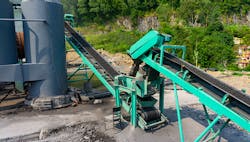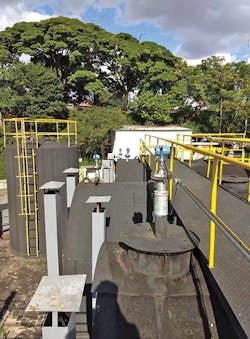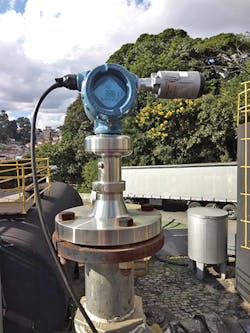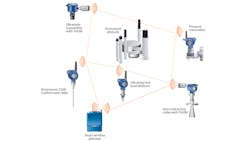Radar level transmitters, wireless streamline Vedacit's asphalt production
Few materials are stickier and harder to handle asphalt and other viscous hydrocarbons. This makes them equally difficult to measure, even though it's crucial to efficiently processing them, maintaining quality and avoiding adverse incidents.
To solve these recurring challenges, Brazil-based construction products manufacturer Vedacit requires accurate and reliable level measurement in the five asphalt boilers at its plant in São Paulo to prevent risks of overfills or other interruptions in its batch process (Figure 1). The plant mostly makes about 26 tons per month of waterproofing, bitumen-based additives for construction and 120 other products. Not only are these sticky products difficult to measure, but the boilers are repeatedly injected with steam to keep the asphalt from hardening, which produces heavy condensation and creates an extremely steamy setting that further impedes level measurement.
Figure 1: Vedacit needs accurate, reliable level measurement in the five asphalt boilers at its São Paulo plant to prevent overfill risks and other interruptions, but not only is the sticky product difficult to measure, the boilers are injected with steam to keep the asphalt from hardening, which causes heavy condensation and a steamy environment that further hinders level measurement. Source: Vedacit and Emerson
Klaus Gutierrez De Carli, industrial operations manager at Vedacit, reports the plant traditionally used rulers and other manual/mechanical devices to measure level in the boilers, but they were understandably prone to clogging, and impacted by the viscous product and ambient condensation. At the same time, stopping production due to unreliable measurements was expensive, plus there were added safety risks when staff had to climb the tanks, which could be slippery from overfills.
Challenge checklist
"Because of ongoing economic demands and now the COVID-19 pandemic, many of Vedacit's facilities, processes and tanks are running at full capacity, especially those that store hydrocarbons," says De Carli. "This makes it even more important to maintain process safety because there's increased potential for accidents when we're running at capacity, and one of the primary ways to improve safety is to have quick, additional layers of measurement."
De Carli reports Vedacit requires level and other measurements to monitor and manage its stocks and products, which are based on many different formulas that need to be adapted for varying raw materials. The 50,000-square-meter São Paulo facility also contains many smaller production sections and fiber-optic and wireless networks, so if Vedacit was going to update or add a new level measurement solution, it couldn't interfere with existing operations and infrastructure.
"Our plant was built in the 1950s, and the asphalt tanks were built in the 1970s. Before that, horizontal tanks processed 20-30 tons of stock from trucks, and later 200-ton bitumen tanks were added for more storage," explains De Carli. "Because our infrastructure wasn't prepared to handle Industry 4.0, we decided to seek a wireless solution, which would be simpler to install and easier to operate—especially because fewer people are now available during to the pandemic.
Figure 2: To measure level in its five heating tanks and finished product vessels, Vedacit implemented non-intrusive Rosemount 5408 non-contacting radar level transmitters with Emerson Wireless 775 Thum adapters, which avoid materials clogs and incorrect reading and easily handle steamy settings. Source: Vedacit and Emrson
"We started with a site survey to decide where we needed level measurements, aligned data expectations, and determined the right connections. This application has five heating tanks and a finished product area for a total of more than 10 tanks. All their instruments would be linked to a wireless mesh network."
Non-sticky solutions, free to measure
Following its survey and evaluation, Vedacit implemented SIL 3-capable Rosemount 5408 non-contacting radar level transmitters with Emerson Wireless 775 Thum adapters by the end of 2019 (Figure 2). The transmitters are non-intrusive, which prevents material clogging to the former mechanicals and causing erroneous readings. They also easily handled the steamy environment in the tanks. The wireless adapters link to Vedacit's 2.4-GHz wireless network, allowing users to access level information with an Emerson 1410 Wireless HART gateway and web browser (Figure 3). The plant also saved about $20,000 compared to the expense of a typical, more intrusive infrastructure project.
In addition, the Rosemount 5408 gauge was designed in accordance with the FieldComm Group's Field Device Integration (FDI) program, so it simplifies operating tasks with pictorial instructions and an intuitive software interface that guides operators through installation, commissioning, proof-testing, operation and maintenance. Its enhanced, on-board diagnostics support preventative maintenance and provide actionable information, streamlining the troubleshooting process. The ability to remotely perform proof-testing and site acceptance tests saves time, increases user efficiency and reduces reliance on more experienced personnel.
"Radar level transmitters like the Rosemount 5408 are addressing three main areas these days," says Phil Lever, business development manager for global level at Emerson Automation Solutions. "The first is the demographic shift of experience lost due to retirements, which means new instruments must be simpler, easier to use and maintain, and as close to plug-and-play as possible for less-experienced users. Rosemount 5408 was designed with users in mind, so its packaging, instructions, configuration and troubleshooting are intuitive. It has built-in memory, so they can view historical data if there's a process upset/anomaly in the output, and it logs all such events with cause and recommended actions instantly available."
Jimmie Soderstrom, business development manager for global level at Emerson, adds: "The second trend in non-contact radar level is safety. One of its main goals is preventing overfills, but safety is affected by changing demographics, too. Many younger engineers are even more concerned about protecting local environments, and this along with increased regulatory focus on environmental and public safety, is increasing demand for innovative safety functions and certifications to safety standards.
"The third trend is that Industry 4.0 and digital transformation are impacting level measurement, and users are demanding devices that can send and receive data from places they couldn't reach before. Of course, wireless can help with this, such as the Rosemount 3308 wireless guided wave radar level transmitter that can work in remote areas where it used to be prohibitive to automate level measurement before. Once users get this new data from their applications, they're sending it to cloud-based storage and analytics programs, which can send back diagnostics and alerts."
Figure 3: Emerson Wireless 775 Thum adapters integrated with Vedacit's existing wireless mesh network allow users at the São Paulo plant to access level information about their five asphalt boilers with a gateway-based web browser, while at the same time, avoiding interference with many other, smaller productions sections at the 50,000-square-meter facility. Source: Vedacit and Emerson
Faster data = quicker production
De Carli reports Vedacit's new radar level and wireless solution allows each shift to get more production capacity from Vedacit's equipment than its former, more labor-intensive methods, and makes maintenance easier, too. "We can also schedule production with fewer problems, which is essential because our market is demanding more just-in-time product, and requires it faster—in just two or three days," sasy De Carli. "We're really into pull production now instead of push production."
De Carli reports non-contact radar level measurement and wireless enables production at the São Paulo plant by providing quick notifications and visibility of conditions and situations without requiring personnel to physically go to the tanks. The radar transmitters also let operators manage their raw material storage better because they can adapt faster to shifting material characteristics and the formula revisions they need. "We know the exact material transfers to make based on exact calculations, which reduces the time we have to wait for a batch to adapt to a new formula, and improves overall equipment effectiveness and user safety. Industry 4.0 solutions can get us more data faster, which reduces waste and costs, and means better results for older processes."
Present and future gains
Since starting up at the end of last year, De Carli estimates that Vedacit's radar level and wireless solution increased its productivity by about 10%, and improved batch and finished product quality by delivering more timely information to its operators. This data helps the plant's operators avoid excessive heat events, as well as the required cooling periods after they occur and time-consuming cleaning procedures. These and other tank-related problems can cost about $15,000 per day in lost production if they weren't addressed. Beyond enabling financial gains, radar level and wireless also allow operators at the São Paulo plant to quickly halt inflammable, diesel-fueled equipment.
"When the level in an asphalt tank gets too low, the bitumen gets too hot, which changes the flow and causes a lot of stoppages," adds De Carli. "However, if the former mechanical level device was clogged and stuck at a high level, then the operators couldn't see the actual low level. Now, we have a better way to maintain and verify higher levels, and avoid low levels."
Emerson's Lever adds that smart radar level transmitters can aid these efforts with diagnostics that indicate the health of the devices and the reliability of their measurements. "Radar level transmitters are providing more data than ever, so the next step is making it accessible in a good way that can add value," says Lever. "This means generating insights that can show how to run processes even more optimally, and that can still require a learning curve, even as we're making progress in many applications."
About the Author

Leaders relevant to this article:





